Contribution to and Impact of Nursing and Midwifery Practice on Patient Safety Agenda
VerifiedAdded on 2023/04/21
|18
|5547
|281
AI Summary
This essay discusses the contribution and impact of nursing and midwifery practice on patient safety agenda. It explores the concepts of clinical governance, medication management, and patient safety in Ireland.
Contribute Materials
Your contribution can guide someone’s learning journey. Share your
documents today.
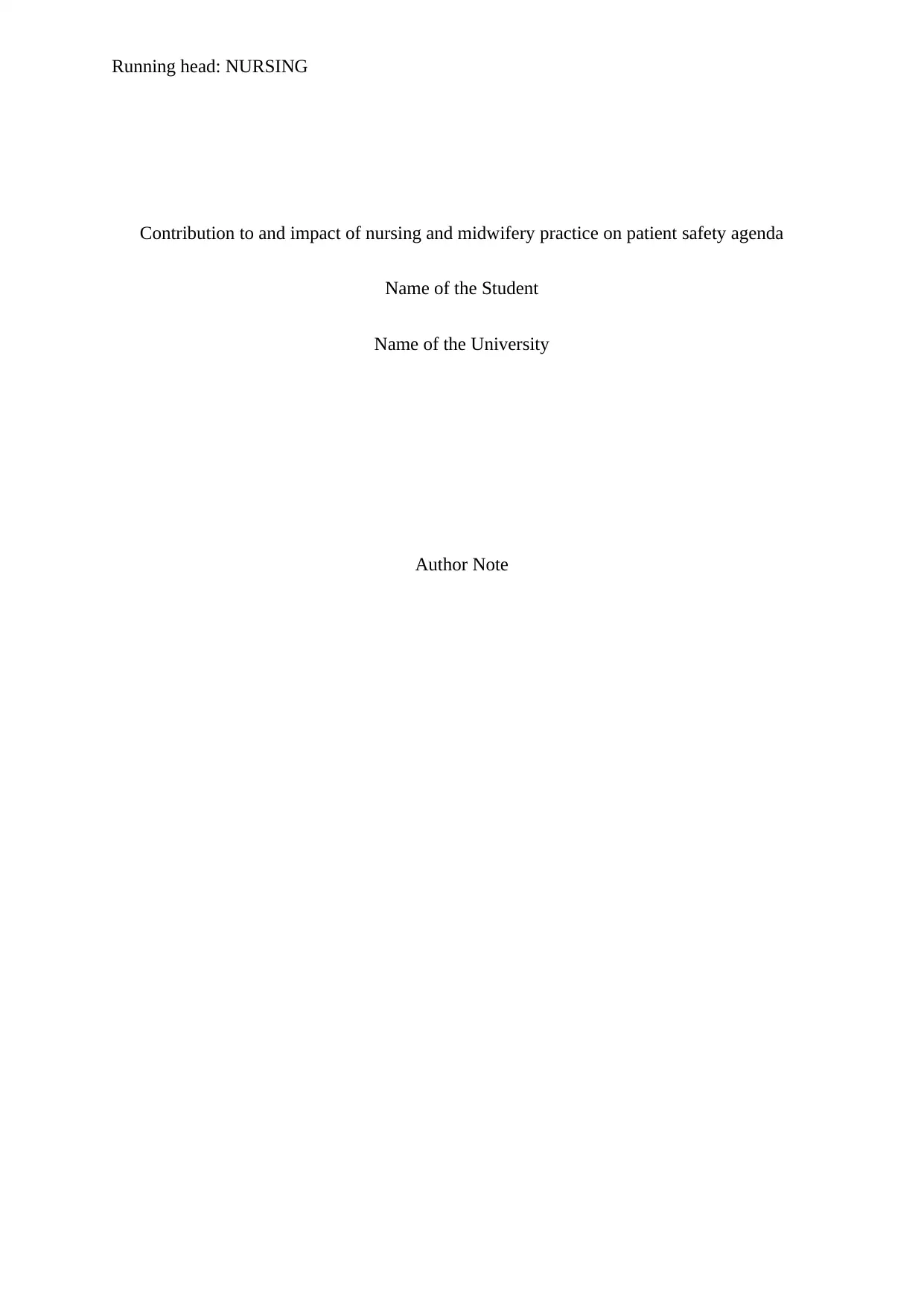
Running head: NURSING
Contribution to and impact of nursing and midwifery practice on patient safety agenda
Name of the Student
Name of the University
Author Note
Contribution to and impact of nursing and midwifery practice on patient safety agenda
Name of the Student
Name of the University
Author Note
Secure Best Marks with AI Grader
Need help grading? Try our AI Grader for instant feedback on your assignments.

1NURSING
Introduction- Patient safety encompasses the discipline that places an emphasis on
the safety of the users of health and social care service through reduction, reporting,
prevention, and analysis of avoidable medical errors that are responsible for the onset of
adverse events (Weller, Boyd and Cumin 2014). According to Mitchell et al. (2016) the
magnitude and frequency of such preventable adverse events that are experienced by patients
were not identified till the early 90s, when reports of several clients facing harm and death
due to medical errors came into recognition. Hence, patient safety can be defined as averting
all forms of harms to all patients and principally focuses on several aspects namely, (i)
preventing errors, (ii) learning from the errors, and (iii) grounded on a safety culture that
encompasses healthcare professionals (Foody et al. 2014). Thus, all efforts must be taken by
the health department to lower the risks of adverse incidents that are allied with exposure of
the service users to medical care, in relation to several conditions and a plethora of diagnosis.
The Department of Health (2018) identifies patient safety as one of the corner stone to
excellence in healthcare. Efforts are also taken by the office to focus on the leading patient
safety strategy initiatives.
This calls for the need of ensuring safe and optimal healthcare services that are
informed by accurate healthcare data and further reinforced by legislation. In the words of
Dekker (2016) administration of several drugs and medication signify the onset of potential
side-effects, and adverse reactions, during interaction of the drug with counter-medications,
food or supplement. Additionally, several caregivers and service users are unaware of the
warnings that are associated with medication management. Owing to the fact that almost all
medications come with warnings related to potential health risks, proper management is
imperative for ensuring patient safety (Carayon, Xie and Kianfar 2014). This essay will
critically discuss medication management and patient safety in Ireland, in relation to clinical
governance, clinical effectiveness, and quality improvement.
Introduction- Patient safety encompasses the discipline that places an emphasis on
the safety of the users of health and social care service through reduction, reporting,
prevention, and analysis of avoidable medical errors that are responsible for the onset of
adverse events (Weller, Boyd and Cumin 2014). According to Mitchell et al. (2016) the
magnitude and frequency of such preventable adverse events that are experienced by patients
were not identified till the early 90s, when reports of several clients facing harm and death
due to medical errors came into recognition. Hence, patient safety can be defined as averting
all forms of harms to all patients and principally focuses on several aspects namely, (i)
preventing errors, (ii) learning from the errors, and (iii) grounded on a safety culture that
encompasses healthcare professionals (Foody et al. 2014). Thus, all efforts must be taken by
the health department to lower the risks of adverse incidents that are allied with exposure of
the service users to medical care, in relation to several conditions and a plethora of diagnosis.
The Department of Health (2018) identifies patient safety as one of the corner stone to
excellence in healthcare. Efforts are also taken by the office to focus on the leading patient
safety strategy initiatives.
This calls for the need of ensuring safe and optimal healthcare services that are
informed by accurate healthcare data and further reinforced by legislation. In the words of
Dekker (2016) administration of several drugs and medication signify the onset of potential
side-effects, and adverse reactions, during interaction of the drug with counter-medications,
food or supplement. Additionally, several caregivers and service users are unaware of the
warnings that are associated with medication management. Owing to the fact that almost all
medications come with warnings related to potential health risks, proper management is
imperative for ensuring patient safety (Carayon, Xie and Kianfar 2014). This essay will
critically discuss medication management and patient safety in Ireland, in relation to clinical
governance, clinical effectiveness, and quality improvement.

2NURSING
Clinical governance- Clinical governance refers to the safety and quality of patient
care and encompasses activities that are undertaken for achieving high principles of clinical
care (Van Zwanenberg and Edwards 2018). According to the Department of Health (2018)
clinical governance refers to the presence of definite framework through which the healthcare
organisations are held answerable for repeatedly improving the excellence of their facilities
and conservation of great standards of care by generating an atmosphere in which brilliance
in medical care will be achieved (Smith, Latter and Blenkinsopp 2014). Hence, according to
the Department of Health and Children (2011) clinical governance has been developed for the
public health services and HSE for ensuring clear lines of accountabilities and responsibilities
for uniform quality care. The Commission often refers to different barriers that are
encountered while dealing with healthcare professionals who are incompetent, unsafe
practices, and errors in the diagnosis and management of health conditions. The government
has also recognised the need of incorporating clinical governance as an important component
of governance arrangements under situations where a person knows the function and purpose
of accountability and leadership for good social and health care.
There is mounting evidence for the fact that key constituents of clinical governance
involve different aspects namely, (i) skills and knowledge, (ii) information, (iii)
accountability and leadership, (iv) relationships, (v) culture, and (vi) quality improvement
(Hooshmand et al. 2014). Within the domain of clinical governance, patient safety has been
recognised as a top priority for the different organisations under the government, with their
primary goal being aversion of all kinds of avoidable harm. Although traditional medical
training put a focus on acquisition of skills and knowledge that are related to therapeutic
procedures and diagnostic intervention, the government makes it necessary to develop
standards that are nationally decided, with correct accounts of the designates errands,
delegated heights of authority, recording relationships and answerability within the
Clinical governance- Clinical governance refers to the safety and quality of patient
care and encompasses activities that are undertaken for achieving high principles of clinical
care (Van Zwanenberg and Edwards 2018). According to the Department of Health (2018)
clinical governance refers to the presence of definite framework through which the healthcare
organisations are held answerable for repeatedly improving the excellence of their facilities
and conservation of great standards of care by generating an atmosphere in which brilliance
in medical care will be achieved (Smith, Latter and Blenkinsopp 2014). Hence, according to
the Department of Health and Children (2011) clinical governance has been developed for the
public health services and HSE for ensuring clear lines of accountabilities and responsibilities
for uniform quality care. The Commission often refers to different barriers that are
encountered while dealing with healthcare professionals who are incompetent, unsafe
practices, and errors in the diagnosis and management of health conditions. The government
has also recognised the need of incorporating clinical governance as an important component
of governance arrangements under situations where a person knows the function and purpose
of accountability and leadership for good social and health care.
There is mounting evidence for the fact that key constituents of clinical governance
involve different aspects namely, (i) skills and knowledge, (ii) information, (iii)
accountability and leadership, (iv) relationships, (v) culture, and (vi) quality improvement
(Hooshmand et al. 2014). Within the domain of clinical governance, patient safety has been
recognised as a top priority for the different organisations under the government, with their
primary goal being aversion of all kinds of avoidable harm. Although traditional medical
training put a focus on acquisition of skills and knowledge that are related to therapeutic
procedures and diagnostic intervention, the government makes it necessary to develop
standards that are nationally decided, with correct accounts of the designates errands,
delegated heights of authority, recording relationships and answerability within the
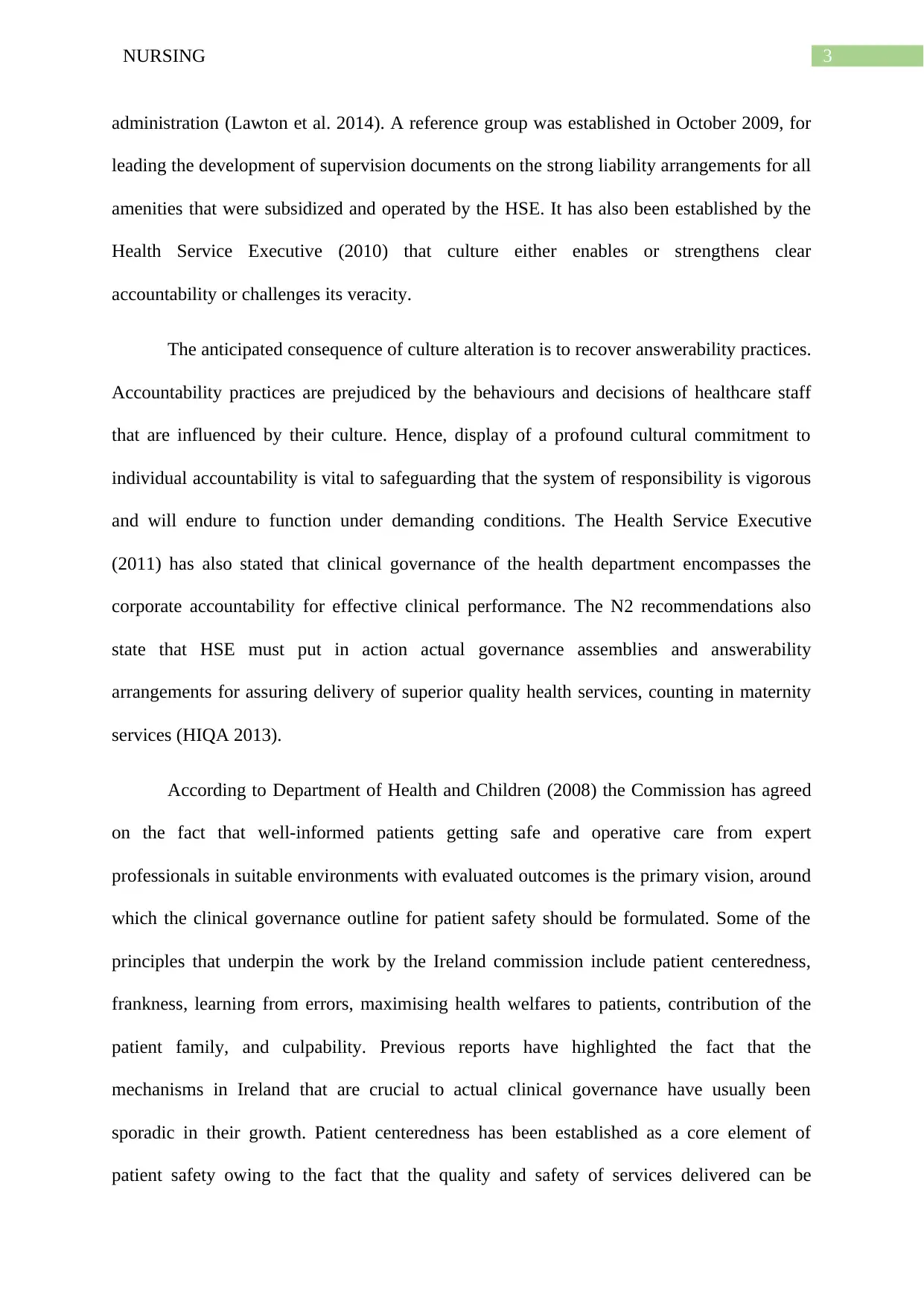
3NURSING
administration (Lawton et al. 2014). A reference group was established in October 2009, for
leading the development of supervision documents on the strong liability arrangements for all
amenities that were subsidized and operated by the HSE. It has also been established by the
Health Service Executive (2010) that culture either enables or strengthens clear
accountability or challenges its veracity.
The anticipated consequence of culture alteration is to recover answerability practices.
Accountability practices are prejudiced by the behaviours and decisions of healthcare staff
that are influenced by their culture. Hence, display of a profound cultural commitment to
individual accountability is vital to safeguarding that the system of responsibility is vigorous
and will endure to function under demanding conditions. The Health Service Executive
(2011) has also stated that clinical governance of the health department encompasses the
corporate accountability for effective clinical performance. The N2 recommendations also
state that HSE must put in action actual governance assemblies and answerability
arrangements for assuring delivery of superior quality health services, counting in maternity
services (HIQA 2013).
According to Department of Health and Children (2008) the Commission has agreed
on the fact that well-informed patients getting safe and operative care from expert
professionals in suitable environments with evaluated outcomes is the primary vision, around
which the clinical governance outline for patient safety should be formulated. Some of the
principles that underpin the work by the Ireland commission include patient centeredness,
frankness, learning from errors, maximising health welfares to patients, contribution of the
patient family, and culpability. Previous reports have highlighted the fact that the
mechanisms in Ireland that are crucial to actual clinical governance have usually been
sporadic in their growth. Patient centeredness has been established as a core element of
patient safety owing to the fact that the quality and safety of services delivered can be
administration (Lawton et al. 2014). A reference group was established in October 2009, for
leading the development of supervision documents on the strong liability arrangements for all
amenities that were subsidized and operated by the HSE. It has also been established by the
Health Service Executive (2010) that culture either enables or strengthens clear
accountability or challenges its veracity.
The anticipated consequence of culture alteration is to recover answerability practices.
Accountability practices are prejudiced by the behaviours and decisions of healthcare staff
that are influenced by their culture. Hence, display of a profound cultural commitment to
individual accountability is vital to safeguarding that the system of responsibility is vigorous
and will endure to function under demanding conditions. The Health Service Executive
(2011) has also stated that clinical governance of the health department encompasses the
corporate accountability for effective clinical performance. The N2 recommendations also
state that HSE must put in action actual governance assemblies and answerability
arrangements for assuring delivery of superior quality health services, counting in maternity
services (HIQA 2013).
According to Department of Health and Children (2008) the Commission has agreed
on the fact that well-informed patients getting safe and operative care from expert
professionals in suitable environments with evaluated outcomes is the primary vision, around
which the clinical governance outline for patient safety should be formulated. Some of the
principles that underpin the work by the Ireland commission include patient centeredness,
frankness, learning from errors, maximising health welfares to patients, contribution of the
patient family, and culpability. Previous reports have highlighted the fact that the
mechanisms in Ireland that are crucial to actual clinical governance have usually been
sporadic in their growth. Patient centeredness has been established as a core element of
patient safety owing to the fact that the quality and safety of services delivered can be
Secure Best Marks with AI Grader
Need help grading? Try our AI Grader for instant feedback on your assignments.
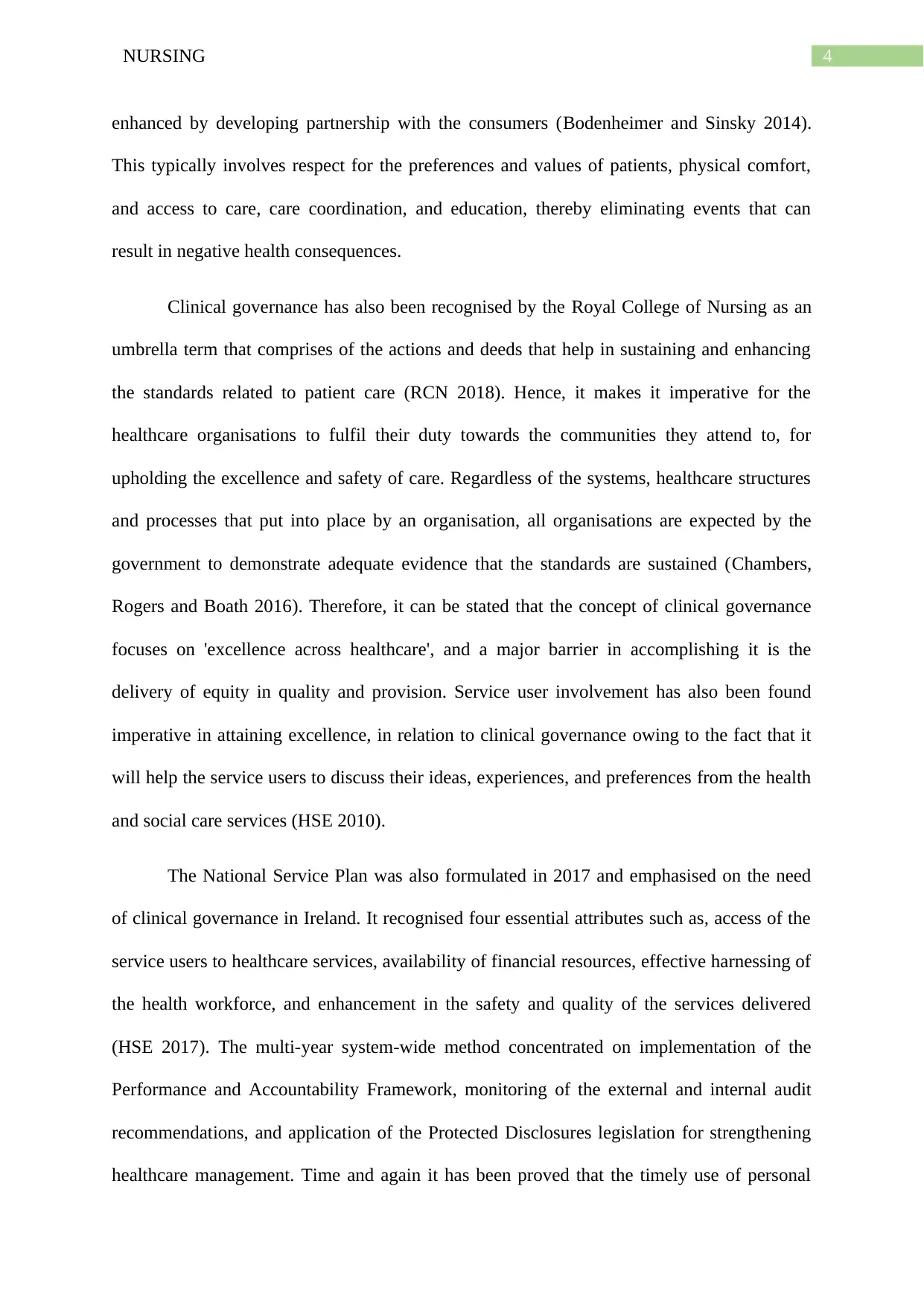
4NURSING
enhanced by developing partnership with the consumers (Bodenheimer and Sinsky 2014).
This typically involves respect for the preferences and values of patients, physical comfort,
and access to care, care coordination, and education, thereby eliminating events that can
result in negative health consequences.
Clinical governance has also been recognised by the Royal College of Nursing as an
umbrella term that comprises of the actions and deeds that help in sustaining and enhancing
the standards related to patient care (RCN 2018). Hence, it makes it imperative for the
healthcare organisations to fulfil their duty towards the communities they attend to, for
upholding the excellence and safety of care. Regardless of the systems, healthcare structures
and processes that put into place by an organisation, all organisations are expected by the
government to demonstrate adequate evidence that the standards are sustained (Chambers,
Rogers and Boath 2016). Therefore, it can be stated that the concept of clinical governance
focuses on 'excellence across healthcare', and a major barrier in accomplishing it is the
delivery of equity in quality and provision. Service user involvement has also been found
imperative in attaining excellence, in relation to clinical governance owing to the fact that it
will help the service users to discuss their ideas, experiences, and preferences from the health
and social care services (HSE 2010).
The National Service Plan was also formulated in 2017 and emphasised on the need
of clinical governance in Ireland. It recognised four essential attributes such as, access of the
service users to healthcare services, availability of financial resources, effective harnessing of
the health workforce, and enhancement in the safety and quality of the services delivered
(HSE 2017). The multi-year system-wide method concentrated on implementation of the
Performance and Accountability Framework, monitoring of the external and internal audit
recommendations, and application of the Protected Disclosures legislation for strengthening
healthcare management. Time and again it has been proved that the timely use of personal
enhanced by developing partnership with the consumers (Bodenheimer and Sinsky 2014).
This typically involves respect for the preferences and values of patients, physical comfort,
and access to care, care coordination, and education, thereby eliminating events that can
result in negative health consequences.
Clinical governance has also been recognised by the Royal College of Nursing as an
umbrella term that comprises of the actions and deeds that help in sustaining and enhancing
the standards related to patient care (RCN 2018). Hence, it makes it imperative for the
healthcare organisations to fulfil their duty towards the communities they attend to, for
upholding the excellence and safety of care. Regardless of the systems, healthcare structures
and processes that put into place by an organisation, all organisations are expected by the
government to demonstrate adequate evidence that the standards are sustained (Chambers,
Rogers and Boath 2016). Therefore, it can be stated that the concept of clinical governance
focuses on 'excellence across healthcare', and a major barrier in accomplishing it is the
delivery of equity in quality and provision. Service user involvement has also been found
imperative in attaining excellence, in relation to clinical governance owing to the fact that it
will help the service users to discuss their ideas, experiences, and preferences from the health
and social care services (HSE 2010).
The National Service Plan was also formulated in 2017 and emphasised on the need
of clinical governance in Ireland. It recognised four essential attributes such as, access of the
service users to healthcare services, availability of financial resources, effective harnessing of
the health workforce, and enhancement in the safety and quality of the services delivered
(HSE 2017). The multi-year system-wide method concentrated on implementation of the
Performance and Accountability Framework, monitoring of the external and internal audit
recommendations, and application of the Protected Disclosures legislation for strengthening
healthcare management. Time and again it has been proved that the timely use of personal
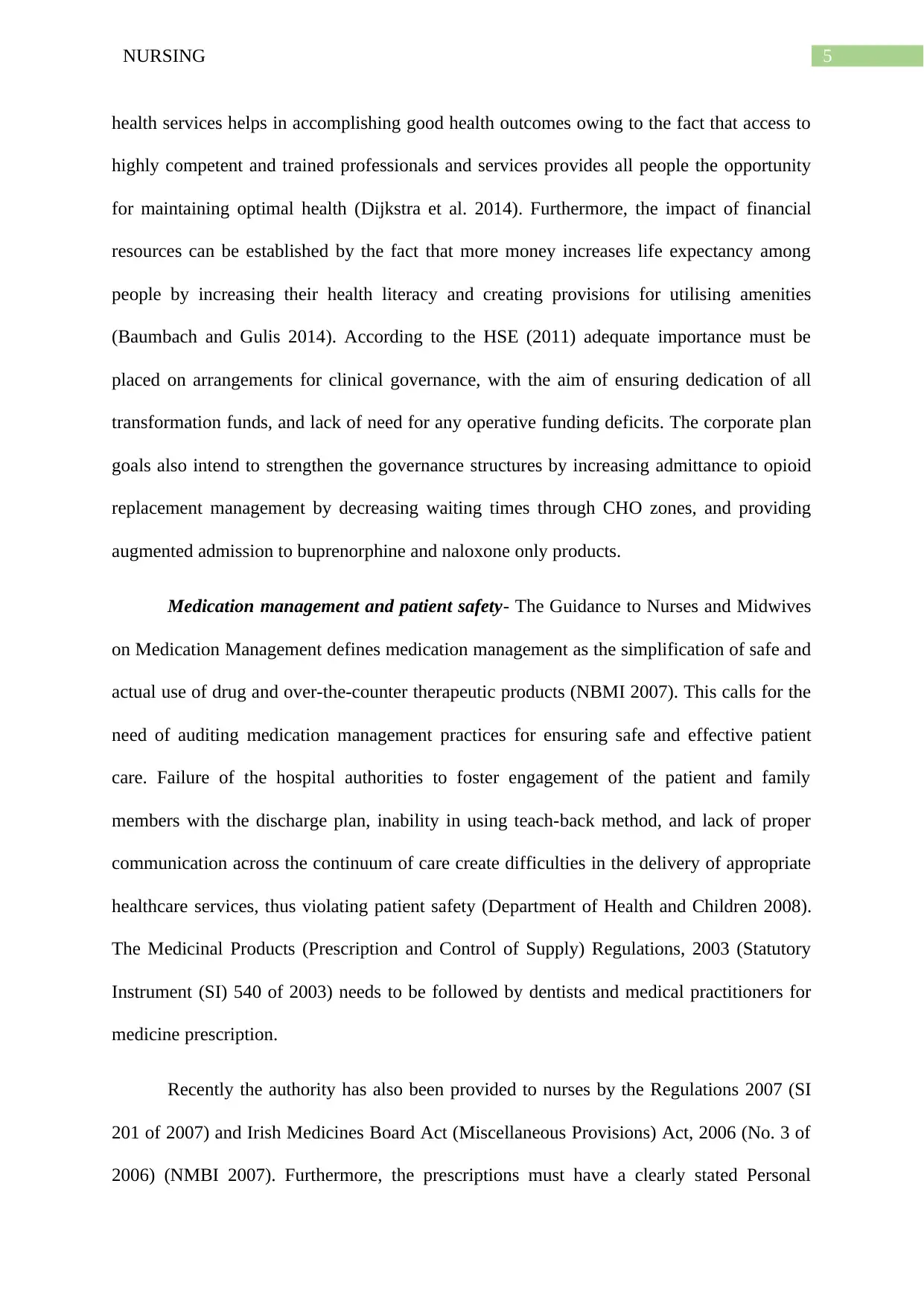
5NURSING
health services helps in accomplishing good health outcomes owing to the fact that access to
highly competent and trained professionals and services provides all people the opportunity
for maintaining optimal health (Dijkstra et al. 2014). Furthermore, the impact of financial
resources can be established by the fact that more money increases life expectancy among
people by increasing their health literacy and creating provisions for utilising amenities
(Baumbach and Gulis 2014). According to the HSE (2011) adequate importance must be
placed on arrangements for clinical governance, with the aim of ensuring dedication of all
transformation funds, and lack of need for any operative funding deficits. The corporate plan
goals also intend to strengthen the governance structures by increasing admittance to opioid
replacement management by decreasing waiting times through CHO zones, and providing
augmented admission to buprenorphine and naloxone only products.
Medication management and patient safety- The Guidance to Nurses and Midwives
on Medication Management defines medication management as the simplification of safe and
actual use of drug and over-the-counter therapeutic products (NBMI 2007). This calls for the
need of auditing medication management practices for ensuring safe and effective patient
care. Failure of the hospital authorities to foster engagement of the patient and family
members with the discharge plan, inability in using teach-back method, and lack of proper
communication across the continuum of care create difficulties in the delivery of appropriate
healthcare services, thus violating patient safety (Department of Health and Children 2008).
The Medicinal Products (Prescription and Control of Supply) Regulations, 2003 (Statutory
Instrument (SI) 540 of 2003) needs to be followed by dentists and medical practitioners for
medicine prescription.
Recently the authority has also been provided to nurses by the Regulations 2007 (SI
201 of 2007) and Irish Medicines Board Act (Miscellaneous Provisions) Act, 2006 (No. 3 of
2006) (NMBI 2007). Furthermore, the prescriptions must have a clearly stated Personal
health services helps in accomplishing good health outcomes owing to the fact that access to
highly competent and trained professionals and services provides all people the opportunity
for maintaining optimal health (Dijkstra et al. 2014). Furthermore, the impact of financial
resources can be established by the fact that more money increases life expectancy among
people by increasing their health literacy and creating provisions for utilising amenities
(Baumbach and Gulis 2014). According to the HSE (2011) adequate importance must be
placed on arrangements for clinical governance, with the aim of ensuring dedication of all
transformation funds, and lack of need for any operative funding deficits. The corporate plan
goals also intend to strengthen the governance structures by increasing admittance to opioid
replacement management by decreasing waiting times through CHO zones, and providing
augmented admission to buprenorphine and naloxone only products.
Medication management and patient safety- The Guidance to Nurses and Midwives
on Medication Management defines medication management as the simplification of safe and
actual use of drug and over-the-counter therapeutic products (NBMI 2007). This calls for the
need of auditing medication management practices for ensuring safe and effective patient
care. Failure of the hospital authorities to foster engagement of the patient and family
members with the discharge plan, inability in using teach-back method, and lack of proper
communication across the continuum of care create difficulties in the delivery of appropriate
healthcare services, thus violating patient safety (Department of Health and Children 2008).
The Medicinal Products (Prescription and Control of Supply) Regulations, 2003 (Statutory
Instrument (SI) 540 of 2003) needs to be followed by dentists and medical practitioners for
medicine prescription.
Recently the authority has also been provided to nurses by the Regulations 2007 (SI
201 of 2007) and Irish Medicines Board Act (Miscellaneous Provisions) Act, 2006 (No. 3 of
2006) (NMBI 2007). Furthermore, the prescriptions must have a clearly stated Personal

6NURSING
Identification Number (PIN). This can be accredited to the fact that medication management
is one of the five core domains that helps in preventing avoidable hospital readmissions,
besides ensuring low rates of illness, and subsequent death, and concomitant good health
outcomes for the elderly (Kuntz et al. 2014). The guidelines are in accordance to research
evidences on the key factors that need to be considered while determining the scope of
nursing practice namely, delegation, emergency situations, support for specialised nursing
and midwifery practice, on-going professional development, autonomy and responsibility,
and competence (Cashin et al. 2017). HIQA is also a member of the Patient Safety First
initiative that aims at increasing awareness for healthcare societies to announce their
obligation to patient safety. The associates work towards fulfilling their role in refining the
security and quality of healthcare amenities (HIQA 2012). Time and again it has been proved
that medication management comprises of the patient-centred care, which augments safe,
actual, fitting drug therapy (Wallace et al. 2015). In other words, medication management has
been identified as one of the core domains that play an important role in lowering the rates of
preventable readmissions of patients to hospitals. This calls for the need of all healthcare
settings to place adequate emphasis on improving the usage of medicines for the patient's
illness and safeguarding that the patient comprehends the potential advantages of the
medicines and are consuming them in a correct method at the right time.
In addition, in the words of Leguelinel-Blache et al. (2014) interventions for
enhancing patient safety also comprise of patient and family education on prescriptions,
medication reconciliation, medication set-up replications, and medication therapy
administration for the patient and/or family members. However, it has often been found that
there exists lack of appropriate clinical governance arrangement in relation to the context of
patient safety. The death of Ms. Savita Halappanavar is one such case where a thorough
investigation led to the recognition of the major causal factors. According to HSE (2013) the
Identification Number (PIN). This can be accredited to the fact that medication management
is one of the five core domains that helps in preventing avoidable hospital readmissions,
besides ensuring low rates of illness, and subsequent death, and concomitant good health
outcomes for the elderly (Kuntz et al. 2014). The guidelines are in accordance to research
evidences on the key factors that need to be considered while determining the scope of
nursing practice namely, delegation, emergency situations, support for specialised nursing
and midwifery practice, on-going professional development, autonomy and responsibility,
and competence (Cashin et al. 2017). HIQA is also a member of the Patient Safety First
initiative that aims at increasing awareness for healthcare societies to announce their
obligation to patient safety. The associates work towards fulfilling their role in refining the
security and quality of healthcare amenities (HIQA 2012). Time and again it has been proved
that medication management comprises of the patient-centred care, which augments safe,
actual, fitting drug therapy (Wallace et al. 2015). In other words, medication management has
been identified as one of the core domains that play an important role in lowering the rates of
preventable readmissions of patients to hospitals. This calls for the need of all healthcare
settings to place adequate emphasis on improving the usage of medicines for the patient's
illness and safeguarding that the patient comprehends the potential advantages of the
medicines and are consuming them in a correct method at the right time.
In addition, in the words of Leguelinel-Blache et al. (2014) interventions for
enhancing patient safety also comprise of patient and family education on prescriptions,
medication reconciliation, medication set-up replications, and medication therapy
administration for the patient and/or family members. However, it has often been found that
there exists lack of appropriate clinical governance arrangement in relation to the context of
patient safety. The death of Ms. Savita Halappanavar is one such case where a thorough
investigation led to the recognition of the major causal factors. According to HSE (2013) the
Paraphrase This Document
Need a fresh take? Get an instant paraphrase of this document with our AI Paraphraser
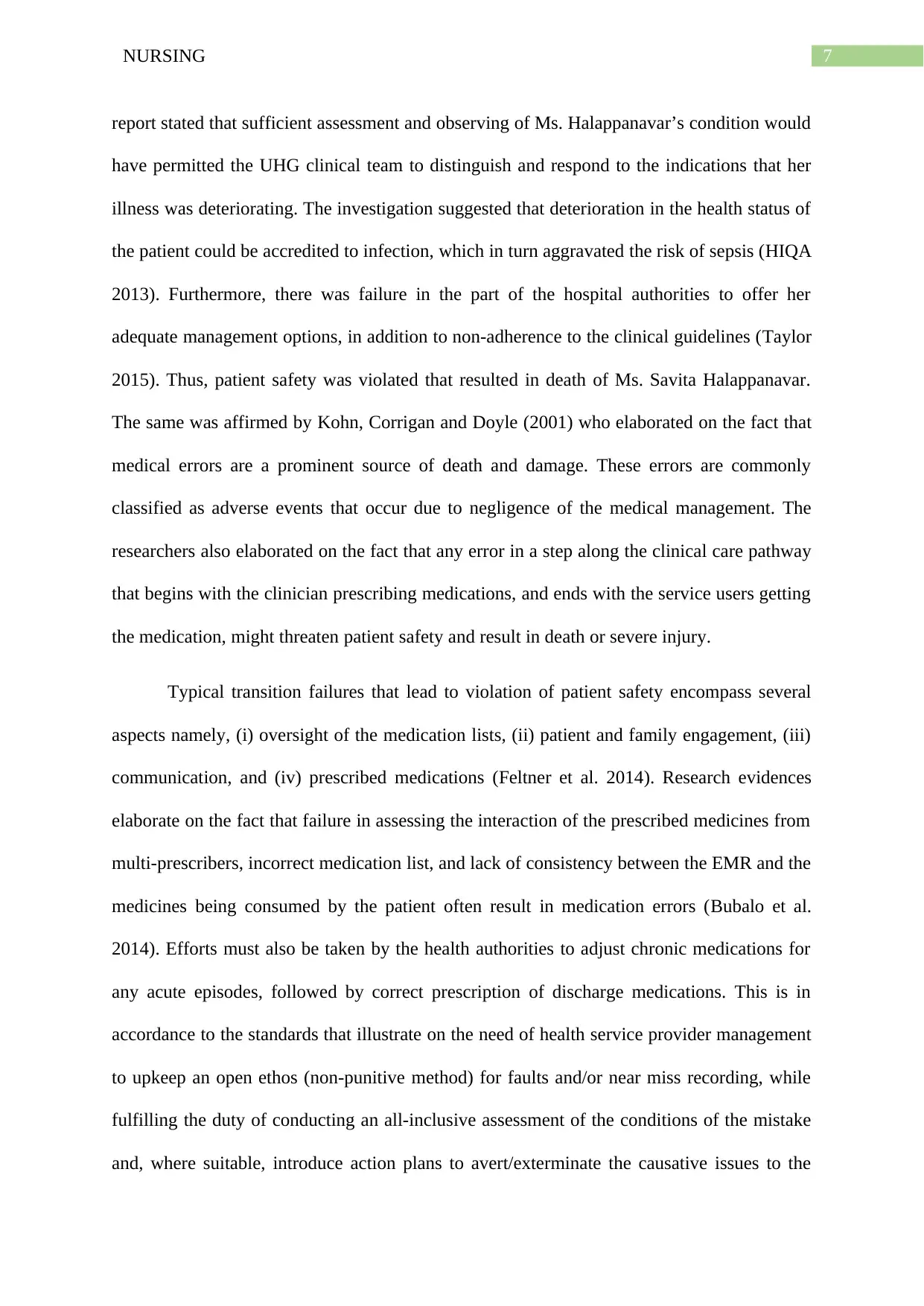
7NURSING
report stated that sufficient assessment and observing of Ms. Halappanavar’s condition would
have permitted the UHG clinical team to distinguish and respond to the indications that her
illness was deteriorating. The investigation suggested that deterioration in the health status of
the patient could be accredited to infection, which in turn aggravated the risk of sepsis (HIQA
2013). Furthermore, there was failure in the part of the hospital authorities to offer her
adequate management options, in addition to non-adherence to the clinical guidelines (Taylor
2015). Thus, patient safety was violated that resulted in death of Ms. Savita Halappanavar.
The same was affirmed by Kohn, Corrigan and Doyle (2001) who elaborated on the fact that
medical errors are a prominent source of death and damage. These errors are commonly
classified as adverse events that occur due to negligence of the medical management. The
researchers also elaborated on the fact that any error in a step along the clinical care pathway
that begins with the clinician prescribing medications, and ends with the service users getting
the medication, might threaten patient safety and result in death or severe injury.
Typical transition failures that lead to violation of patient safety encompass several
aspects namely, (i) oversight of the medication lists, (ii) patient and family engagement, (iii)
communication, and (iv) prescribed medications (Feltner et al. 2014). Research evidences
elaborate on the fact that failure in assessing the interaction of the prescribed medicines from
multi-prescribers, incorrect medication list, and lack of consistency between the EMR and the
medicines being consumed by the patient often result in medication errors (Bubalo et al.
2014). Efforts must also be taken by the health authorities to adjust chronic medications for
any acute episodes, followed by correct prescription of discharge medications. This is in
accordance to the standards that illustrate on the need of health service provider management
to upkeep an open ethos (non-punitive method) for faults and/or near miss recording, while
fulfilling the duty of conducting an all-inclusive assessment of the conditions of the mistake
and, where suitable, introduce action plans to avert/exterminate the causative issues to the
report stated that sufficient assessment and observing of Ms. Halappanavar’s condition would
have permitted the UHG clinical team to distinguish and respond to the indications that her
illness was deteriorating. The investigation suggested that deterioration in the health status of
the patient could be accredited to infection, which in turn aggravated the risk of sepsis (HIQA
2013). Furthermore, there was failure in the part of the hospital authorities to offer her
adequate management options, in addition to non-adherence to the clinical guidelines (Taylor
2015). Thus, patient safety was violated that resulted in death of Ms. Savita Halappanavar.
The same was affirmed by Kohn, Corrigan and Doyle (2001) who elaborated on the fact that
medical errors are a prominent source of death and damage. These errors are commonly
classified as adverse events that occur due to negligence of the medical management. The
researchers also elaborated on the fact that any error in a step along the clinical care pathway
that begins with the clinician prescribing medications, and ends with the service users getting
the medication, might threaten patient safety and result in death or severe injury.
Typical transition failures that lead to violation of patient safety encompass several
aspects namely, (i) oversight of the medication lists, (ii) patient and family engagement, (iii)
communication, and (iv) prescribed medications (Feltner et al. 2014). Research evidences
elaborate on the fact that failure in assessing the interaction of the prescribed medicines from
multi-prescribers, incorrect medication list, and lack of consistency between the EMR and the
medicines being consumed by the patient often result in medication errors (Bubalo et al.
2014). Efforts must also be taken by the health authorities to adjust chronic medications for
any acute episodes, followed by correct prescription of discharge medications. This is in
accordance to the standards that illustrate on the need of health service provider management
to upkeep an open ethos (non-punitive method) for faults and/or near miss recording, while
fulfilling the duty of conducting an all-inclusive assessment of the conditions of the mistake
and, where suitable, introduce action plans to avert/exterminate the causative issues to the
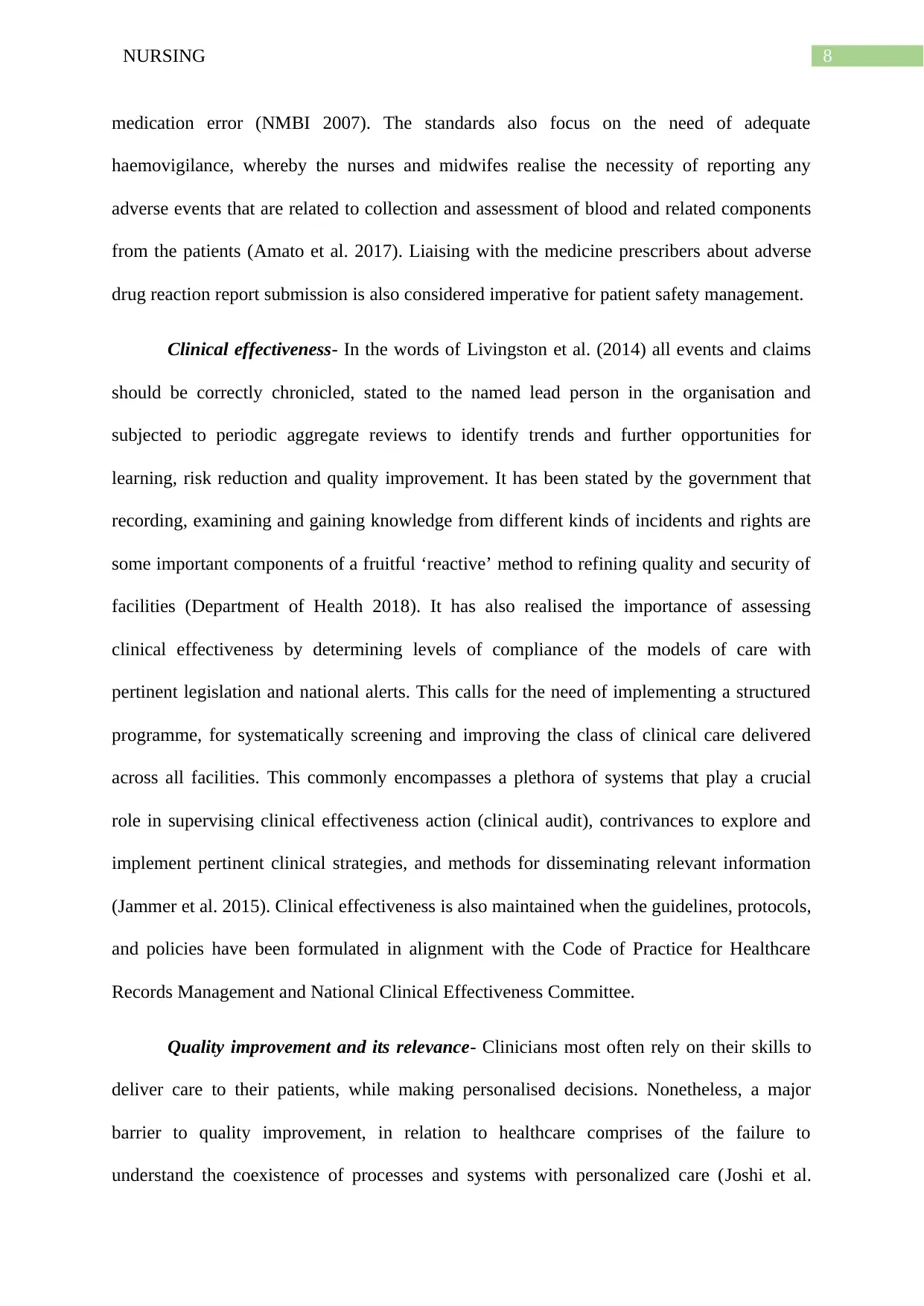
8NURSING
medication error (NMBI 2007). The standards also focus on the need of adequate
haemovigilance, whereby the nurses and midwifes realise the necessity of reporting any
adverse events that are related to collection and assessment of blood and related components
from the patients (Amato et al. 2017). Liaising with the medicine prescribers about adverse
drug reaction report submission is also considered imperative for patient safety management.
Clinical effectiveness- In the words of Livingston et al. (2014) all events and claims
should be correctly chronicled, stated to the named lead person in the organisation and
subjected to periodic aggregate reviews to identify trends and further opportunities for
learning, risk reduction and quality improvement. It has been stated by the government that
recording, examining and gaining knowledge from different kinds of incidents and rights are
some important components of a fruitful ‘reactive’ method to refining quality and security of
facilities (Department of Health 2018). It has also realised the importance of assessing
clinical effectiveness by determining levels of compliance of the models of care with
pertinent legislation and national alerts. This calls for the need of implementing a structured
programme, for systematically screening and improving the class of clinical care delivered
across all facilities. This commonly encompasses a plethora of systems that play a crucial
role in supervising clinical effectiveness action (clinical audit), contrivances to explore and
implement pertinent clinical strategies, and methods for disseminating relevant information
(Jammer et al. 2015). Clinical effectiveness is also maintained when the guidelines, protocols,
and policies have been formulated in alignment with the Code of Practice for Healthcare
Records Management and National Clinical Effectiveness Committee.
Quality improvement and its relevance- Clinicians most often rely on their skills to
deliver care to their patients, while making personalised decisions. Nonetheless, a major
barrier to quality improvement, in relation to healthcare comprises of the failure to
understand the coexistence of processes and systems with personalized care (Joshi et al.
medication error (NMBI 2007). The standards also focus on the need of adequate
haemovigilance, whereby the nurses and midwifes realise the necessity of reporting any
adverse events that are related to collection and assessment of blood and related components
from the patients (Amato et al. 2017). Liaising with the medicine prescribers about adverse
drug reaction report submission is also considered imperative for patient safety management.
Clinical effectiveness- In the words of Livingston et al. (2014) all events and claims
should be correctly chronicled, stated to the named lead person in the organisation and
subjected to periodic aggregate reviews to identify trends and further opportunities for
learning, risk reduction and quality improvement. It has been stated by the government that
recording, examining and gaining knowledge from different kinds of incidents and rights are
some important components of a fruitful ‘reactive’ method to refining quality and security of
facilities (Department of Health 2018). It has also realised the importance of assessing
clinical effectiveness by determining levels of compliance of the models of care with
pertinent legislation and national alerts. This calls for the need of implementing a structured
programme, for systematically screening and improving the class of clinical care delivered
across all facilities. This commonly encompasses a plethora of systems that play a crucial
role in supervising clinical effectiveness action (clinical audit), contrivances to explore and
implement pertinent clinical strategies, and methods for disseminating relevant information
(Jammer et al. 2015). Clinical effectiveness is also maintained when the guidelines, protocols,
and policies have been formulated in alignment with the Code of Practice for Healthcare
Records Management and National Clinical Effectiveness Committee.
Quality improvement and its relevance- Clinicians most often rely on their skills to
deliver care to their patients, while making personalised decisions. Nonetheless, a major
barrier to quality improvement, in relation to healthcare comprises of the failure to
understand the coexistence of processes and systems with personalized care (Joshi et al.
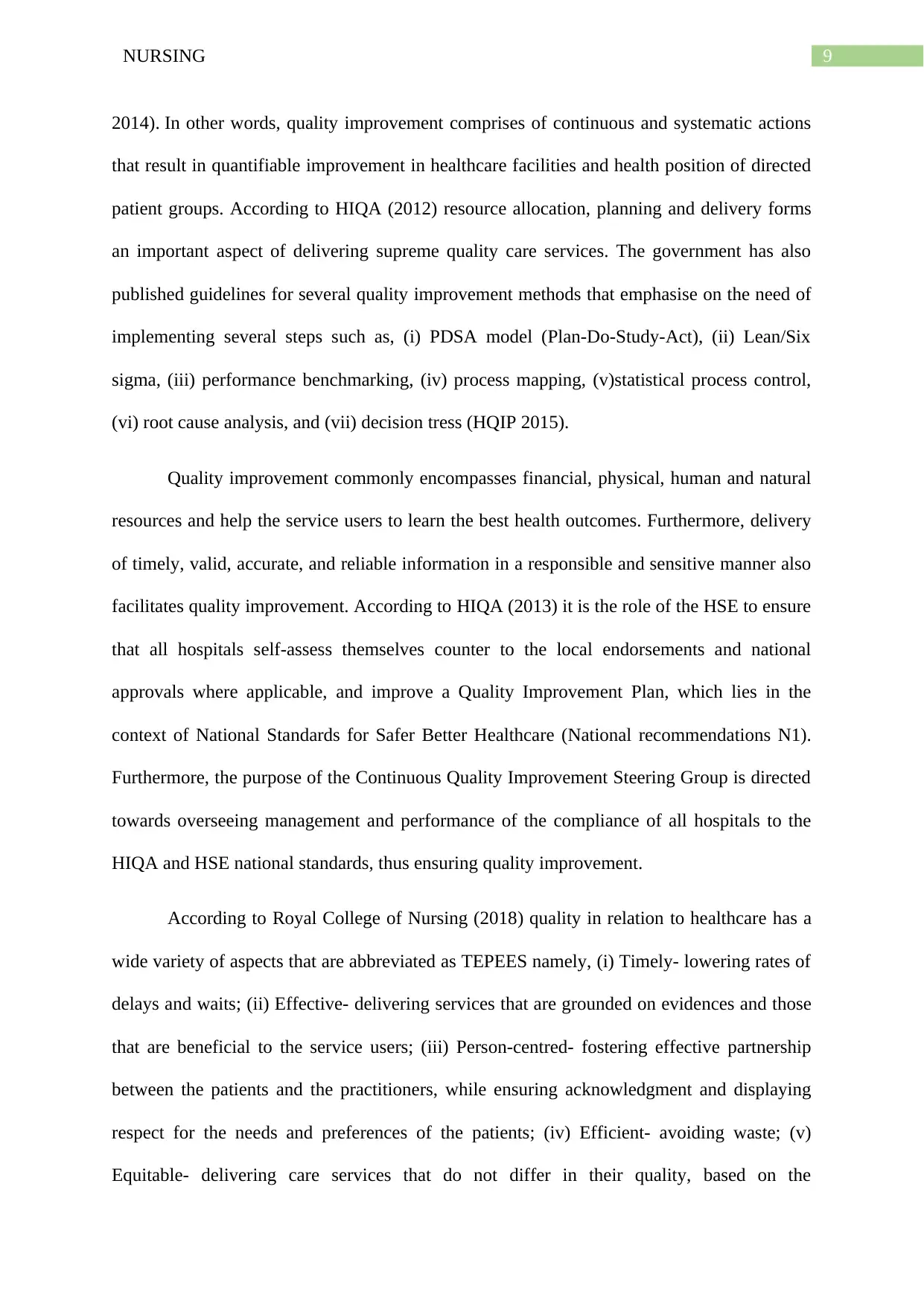
9NURSING
2014). In other words, quality improvement comprises of continuous and systematic actions
that result in quantifiable improvement in healthcare facilities and health position of directed
patient groups. According to HIQA (2012) resource allocation, planning and delivery forms
an important aspect of delivering supreme quality care services. The government has also
published guidelines for several quality improvement methods that emphasise on the need of
implementing several steps such as, (i) PDSA model (Plan-Do-Study-Act), (ii) Lean/Six
sigma, (iii) performance benchmarking, (iv) process mapping, (v)statistical process control,
(vi) root cause analysis, and (vii) decision tress (HQIP 2015).
Quality improvement commonly encompasses financial, physical, human and natural
resources and help the service users to learn the best health outcomes. Furthermore, delivery
of timely, valid, accurate, and reliable information in a responsible and sensitive manner also
facilitates quality improvement. According to HIQA (2013) it is the role of the HSE to ensure
that all hospitals self-assess themselves counter to the local endorsements and national
approvals where applicable, and improve a Quality Improvement Plan, which lies in the
context of National Standards for Safer Better Healthcare (National recommendations N1).
Furthermore, the purpose of the Continuous Quality Improvement Steering Group is directed
towards overseeing management and performance of the compliance of all hospitals to the
HIQA and HSE national standards, thus ensuring quality improvement.
According to Royal College of Nursing (2018) quality in relation to healthcare has a
wide variety of aspects that are abbreviated as TEPEES namely, (i) Timely- lowering rates of
delays and waits; (ii) Effective- delivering services that are grounded on evidences and those
that are beneficial to the service users; (iii) Person-centred- fostering effective partnership
between the patients and the practitioners, while ensuring acknowledgment and displaying
respect for the needs and preferences of the patients; (iv) Efficient- avoiding waste; (v)
Equitable- delivering care services that do not differ in their quality, based on the
2014). In other words, quality improvement comprises of continuous and systematic actions
that result in quantifiable improvement in healthcare facilities and health position of directed
patient groups. According to HIQA (2012) resource allocation, planning and delivery forms
an important aspect of delivering supreme quality care services. The government has also
published guidelines for several quality improvement methods that emphasise on the need of
implementing several steps such as, (i) PDSA model (Plan-Do-Study-Act), (ii) Lean/Six
sigma, (iii) performance benchmarking, (iv) process mapping, (v)statistical process control,
(vi) root cause analysis, and (vii) decision tress (HQIP 2015).
Quality improvement commonly encompasses financial, physical, human and natural
resources and help the service users to learn the best health outcomes. Furthermore, delivery
of timely, valid, accurate, and reliable information in a responsible and sensitive manner also
facilitates quality improvement. According to HIQA (2013) it is the role of the HSE to ensure
that all hospitals self-assess themselves counter to the local endorsements and national
approvals where applicable, and improve a Quality Improvement Plan, which lies in the
context of National Standards for Safer Better Healthcare (National recommendations N1).
Furthermore, the purpose of the Continuous Quality Improvement Steering Group is directed
towards overseeing management and performance of the compliance of all hospitals to the
HIQA and HSE national standards, thus ensuring quality improvement.
According to Royal College of Nursing (2018) quality in relation to healthcare has a
wide variety of aspects that are abbreviated as TEPEES namely, (i) Timely- lowering rates of
delays and waits; (ii) Effective- delivering services that are grounded on evidences and those
that are beneficial to the service users; (iii) Person-centred- fostering effective partnership
between the patients and the practitioners, while ensuring acknowledgment and displaying
respect for the needs and preferences of the patients; (iv) Efficient- avoiding waste; (v)
Equitable- delivering care services that do not differ in their quality, based on the
Secure Best Marks with AI Grader
Need help grading? Try our AI Grader for instant feedback on your assignments.

10NURSING
characteristics of a person; and (vi) Safe-preventing any kind of harm to the patients from the
care that is delivered with the intention to assist them. Its relevance can be accredited to the
fact that it helps in preparing for the transition to payment models that are value-based. It also
allows the staff to contribute in the public recording of physician-quality facts. An additional
benefit of quality improvement is the fact that if the healthcare institutions are caught in the
conventional concepts, without any additional enhancements, it will be unsuccessful in
producing better outcomes (Renedo et al. 2015). Streamlining the variations into the
organisation will help in achieving a new level of performance. One such measure adopted in
Ireland is the Slaintecare Implementation Strategy that provides an unparalleled opportunity
for the comprehension of real and continued improvement in the delivery of healthcare to all
inhabitants (Gov.ie 2018).
Conclusion- To conclude, patient safety has been recognized as an indispensable part
of appropriate healthcare service delivery and are imperative for quality improvement. Time
and again clinical governance has been found to be grounded on seven pillars namely, risk
management, service user, public and carer involvement, staff management and staffing,
clinical audit, training and education, clinical efficacy, and clinical information. It has been
framed by the healthcare organisations and government that in order to frame an appropriate
governance framework, there is a need to assign the key leadership roles to professionals
having proper designation, with the aim of implementing clinical leadership to the domain of
health quality and patient safety. The government of Ireland also recognises the need of
ensuring patient safety, by averting the occurrence of incidents that might result in avoidable
medical errors such as, powerful drugs, complicated technologies, prolonged hospitalisation
human factors, system failures, and cost-cutting measures.
The hospitals also work in accordance with the national guidelines and standards,
while bringing about quality improvement and sustaining clinical effectiveness. There is also
characteristics of a person; and (vi) Safe-preventing any kind of harm to the patients from the
care that is delivered with the intention to assist them. Its relevance can be accredited to the
fact that it helps in preparing for the transition to payment models that are value-based. It also
allows the staff to contribute in the public recording of physician-quality facts. An additional
benefit of quality improvement is the fact that if the healthcare institutions are caught in the
conventional concepts, without any additional enhancements, it will be unsuccessful in
producing better outcomes (Renedo et al. 2015). Streamlining the variations into the
organisation will help in achieving a new level of performance. One such measure adopted in
Ireland is the Slaintecare Implementation Strategy that provides an unparalleled opportunity
for the comprehension of real and continued improvement in the delivery of healthcare to all
inhabitants (Gov.ie 2018).
Conclusion- To conclude, patient safety has been recognized as an indispensable part
of appropriate healthcare service delivery and are imperative for quality improvement. Time
and again clinical governance has been found to be grounded on seven pillars namely, risk
management, service user, public and carer involvement, staff management and staffing,
clinical audit, training and education, clinical efficacy, and clinical information. It has been
framed by the healthcare organisations and government that in order to frame an appropriate
governance framework, there is a need to assign the key leadership roles to professionals
having proper designation, with the aim of implementing clinical leadership to the domain of
health quality and patient safety. The government of Ireland also recognises the need of
ensuring patient safety, by averting the occurrence of incidents that might result in avoidable
medical errors such as, powerful drugs, complicated technologies, prolonged hospitalisation
human factors, system failures, and cost-cutting measures.
The hospitals also work in accordance with the national guidelines and standards,
while bringing about quality improvement and sustaining clinical effectiveness. There is also
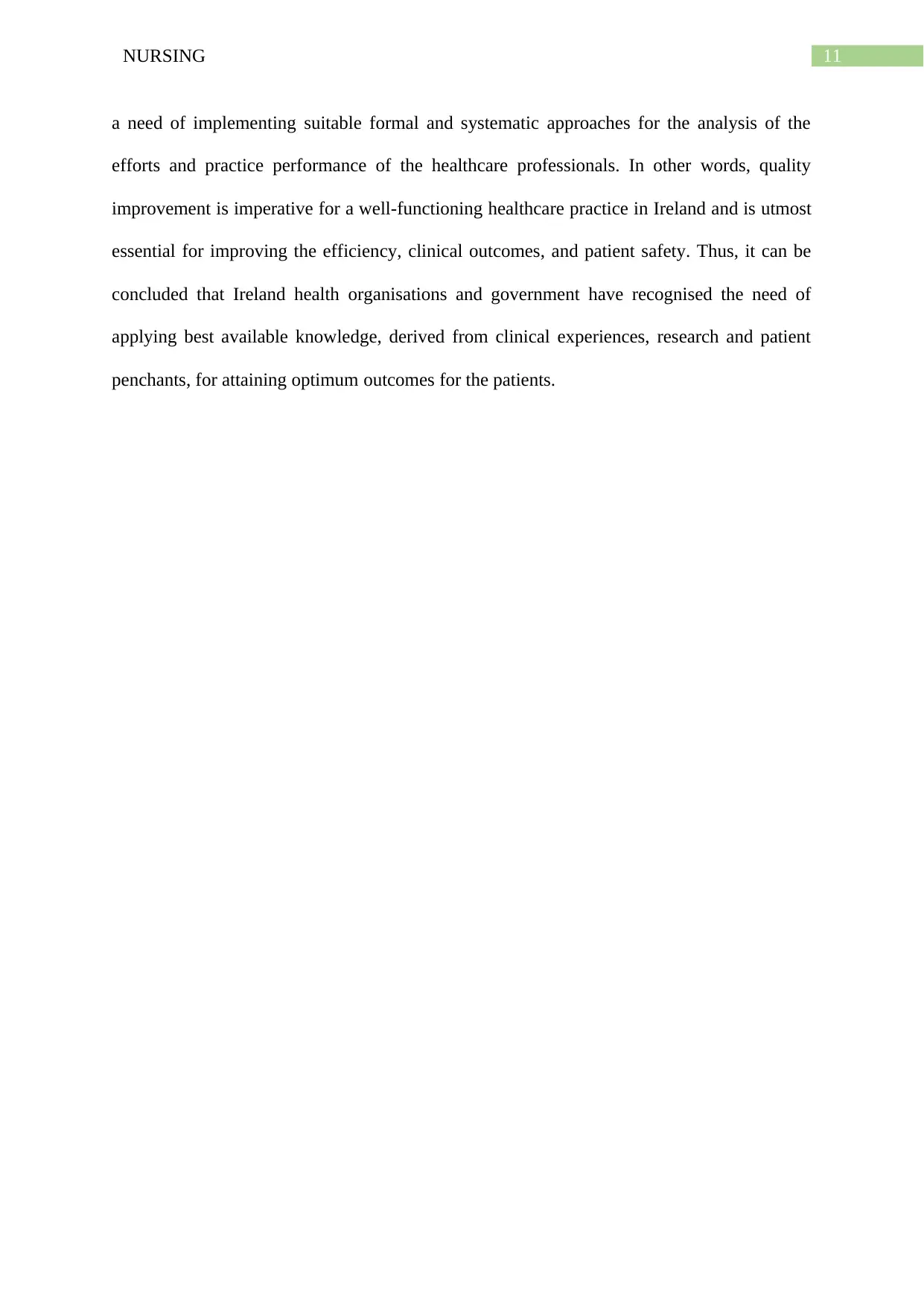
11NURSING
a need of implementing suitable formal and systematic approaches for the analysis of the
efforts and practice performance of the healthcare professionals. In other words, quality
improvement is imperative for a well-functioning healthcare practice in Ireland and is utmost
essential for improving the efficiency, clinical outcomes, and patient safety. Thus, it can be
concluded that Ireland health organisations and government have recognised the need of
applying best available knowledge, derived from clinical experiences, research and patient
penchants, for attaining optimum outcomes for the patients.
a need of implementing suitable formal and systematic approaches for the analysis of the
efforts and practice performance of the healthcare professionals. In other words, quality
improvement is imperative for a well-functioning healthcare practice in Ireland and is utmost
essential for improving the efficiency, clinical outcomes, and patient safety. Thus, it can be
concluded that Ireland health organisations and government have recognised the need of
applying best available knowledge, derived from clinical experiences, research and patient
penchants, for attaining optimum outcomes for the patients.
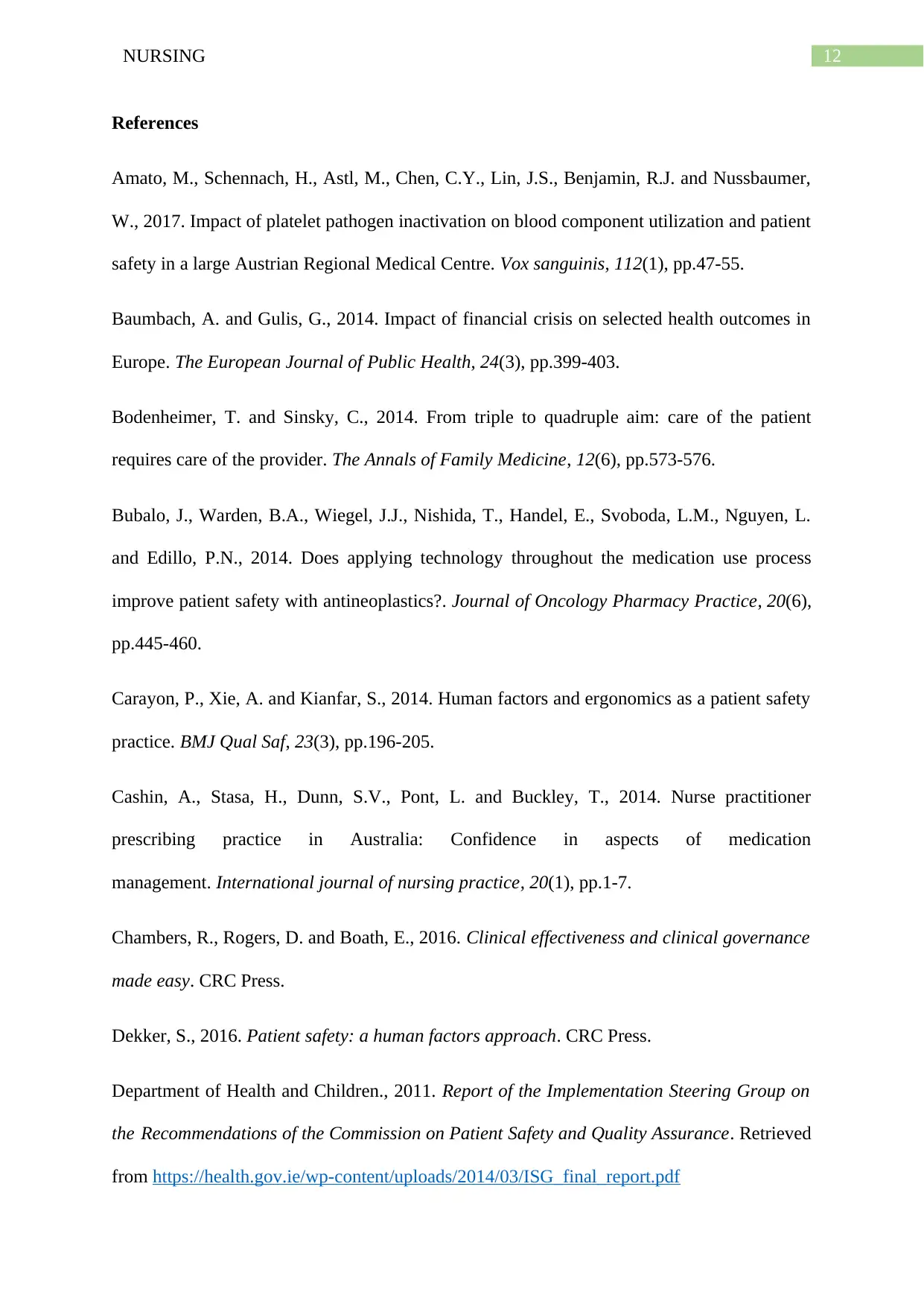
12NURSING
References
Amato, M., Schennach, H., Astl, M., Chen, C.Y., Lin, J.S., Benjamin, R.J. and Nussbaumer,
W., 2017. Impact of platelet pathogen inactivation on blood component utilization and patient
safety in a large Austrian Regional Medical Centre. Vox sanguinis, 112(1), pp.47-55.
Baumbach, A. and Gulis, G., 2014. Impact of financial crisis on selected health outcomes in
Europe. The European Journal of Public Health, 24(3), pp.399-403.
Bodenheimer, T. and Sinsky, C., 2014. From triple to quadruple aim: care of the patient
requires care of the provider. The Annals of Family Medicine, 12(6), pp.573-576.
Bubalo, J., Warden, B.A., Wiegel, J.J., Nishida, T., Handel, E., Svoboda, L.M., Nguyen, L.
and Edillo, P.N., 2014. Does applying technology throughout the medication use process
improve patient safety with antineoplastics?. Journal of Oncology Pharmacy Practice, 20(6),
pp.445-460.
Carayon, P., Xie, A. and Kianfar, S., 2014. Human factors and ergonomics as a patient safety
practice. BMJ Qual Saf, 23(3), pp.196-205.
Cashin, A., Stasa, H., Dunn, S.V., Pont, L. and Buckley, T., 2014. Nurse practitioner
prescribing practice in Australia: Confidence in aspects of medication
management. International journal of nursing practice, 20(1), pp.1-7.
Chambers, R., Rogers, D. and Boath, E., 2016. Clinical effectiveness and clinical governance
made easy. CRC Press.
Dekker, S., 2016. Patient safety: a human factors approach. CRC Press.
Department of Health and Children., 2011. Report of the Implementation Steering Group on
the Recommendations of the Commission on Patient Safety and Quality Assurance. Retrieved
from https://health.gov.ie/wp-content/uploads/2014/03/ISG_final_report.pdf
References
Amato, M., Schennach, H., Astl, M., Chen, C.Y., Lin, J.S., Benjamin, R.J. and Nussbaumer,
W., 2017. Impact of platelet pathogen inactivation on blood component utilization and patient
safety in a large Austrian Regional Medical Centre. Vox sanguinis, 112(1), pp.47-55.
Baumbach, A. and Gulis, G., 2014. Impact of financial crisis on selected health outcomes in
Europe. The European Journal of Public Health, 24(3), pp.399-403.
Bodenheimer, T. and Sinsky, C., 2014. From triple to quadruple aim: care of the patient
requires care of the provider. The Annals of Family Medicine, 12(6), pp.573-576.
Bubalo, J., Warden, B.A., Wiegel, J.J., Nishida, T., Handel, E., Svoboda, L.M., Nguyen, L.
and Edillo, P.N., 2014. Does applying technology throughout the medication use process
improve patient safety with antineoplastics?. Journal of Oncology Pharmacy Practice, 20(6),
pp.445-460.
Carayon, P., Xie, A. and Kianfar, S., 2014. Human factors and ergonomics as a patient safety
practice. BMJ Qual Saf, 23(3), pp.196-205.
Cashin, A., Stasa, H., Dunn, S.V., Pont, L. and Buckley, T., 2014. Nurse practitioner
prescribing practice in Australia: Confidence in aspects of medication
management. International journal of nursing practice, 20(1), pp.1-7.
Chambers, R., Rogers, D. and Boath, E., 2016. Clinical effectiveness and clinical governance
made easy. CRC Press.
Dekker, S., 2016. Patient safety: a human factors approach. CRC Press.
Department of Health and Children., 2011. Report of the Implementation Steering Group on
the Recommendations of the Commission on Patient Safety and Quality Assurance. Retrieved
from https://health.gov.ie/wp-content/uploads/2014/03/ISG_final_report.pdf
Paraphrase This Document
Need a fresh take? Get an instant paraphrase of this document with our AI Paraphraser
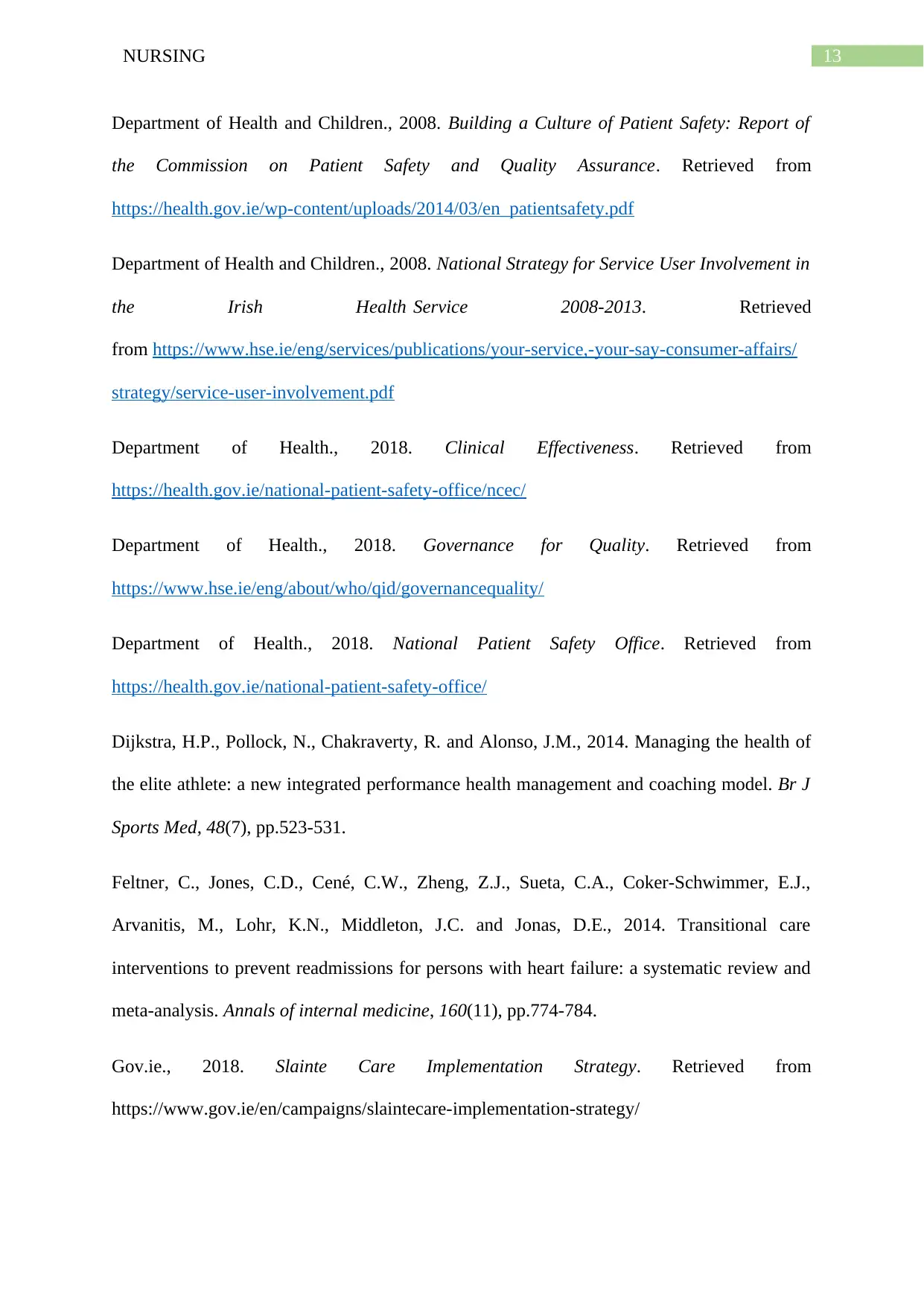
13NURSING
Department of Health and Children., 2008. Building a Culture of Patient Safety: Report of
the Commission on Patient Safety and Quality Assurance. Retrieved from
https://health.gov.ie/wp-content/uploads/2014/03/en_patientsafety.pdf
Department of Health and Children., 2008. National Strategy for Service User Involvement in
the Irish Health Service 2008-2013. Retrieved
from https://www.hse.ie/eng/services/publications/your-service,-your-say-consumer-affairs/
strategy/service-user-involvement.pdf
Department of Health., 2018. Clinical Effectiveness. Retrieved from
https://health.gov.ie/national-patient-safety-office/ncec/
Department of Health., 2018. Governance for Quality. Retrieved from
https://www.hse.ie/eng/about/who/qid/governancequality/
Department of Health., 2018. National Patient Safety Office. Retrieved from
https://health.gov.ie/national-patient-safety-office/
Dijkstra, H.P., Pollock, N., Chakraverty, R. and Alonso, J.M., 2014. Managing the health of
the elite athlete: a new integrated performance health management and coaching model. Br J
Sports Med, 48(7), pp.523-531.
Feltner, C., Jones, C.D., Cené, C.W., Zheng, Z.J., Sueta, C.A., Coker-Schwimmer, E.J.,
Arvanitis, M., Lohr, K.N., Middleton, J.C. and Jonas, D.E., 2014. Transitional care
interventions to prevent readmissions for persons with heart failure: a systematic review and
meta-analysis. Annals of internal medicine, 160(11), pp.774-784.
Gov.ie., 2018. Slainte Care Implementation Strategy. Retrieved from
https://www.gov.ie/en/campaigns/slaintecare-implementation-strategy/
Department of Health and Children., 2008. Building a Culture of Patient Safety: Report of
the Commission on Patient Safety and Quality Assurance. Retrieved from
https://health.gov.ie/wp-content/uploads/2014/03/en_patientsafety.pdf
Department of Health and Children., 2008. National Strategy for Service User Involvement in
the Irish Health Service 2008-2013. Retrieved
from https://www.hse.ie/eng/services/publications/your-service,-your-say-consumer-affairs/
strategy/service-user-involvement.pdf
Department of Health., 2018. Clinical Effectiveness. Retrieved from
https://health.gov.ie/national-patient-safety-office/ncec/
Department of Health., 2018. Governance for Quality. Retrieved from
https://www.hse.ie/eng/about/who/qid/governancequality/
Department of Health., 2018. National Patient Safety Office. Retrieved from
https://health.gov.ie/national-patient-safety-office/
Dijkstra, H.P., Pollock, N., Chakraverty, R. and Alonso, J.M., 2014. Managing the health of
the elite athlete: a new integrated performance health management and coaching model. Br J
Sports Med, 48(7), pp.523-531.
Feltner, C., Jones, C.D., Cené, C.W., Zheng, Z.J., Sueta, C.A., Coker-Schwimmer, E.J.,
Arvanitis, M., Lohr, K.N., Middleton, J.C. and Jonas, D.E., 2014. Transitional care
interventions to prevent readmissions for persons with heart failure: a systematic review and
meta-analysis. Annals of internal medicine, 160(11), pp.774-784.
Gov.ie., 2018. Slainte Care Implementation Strategy. Retrieved from
https://www.gov.ie/en/campaigns/slaintecare-implementation-strategy/
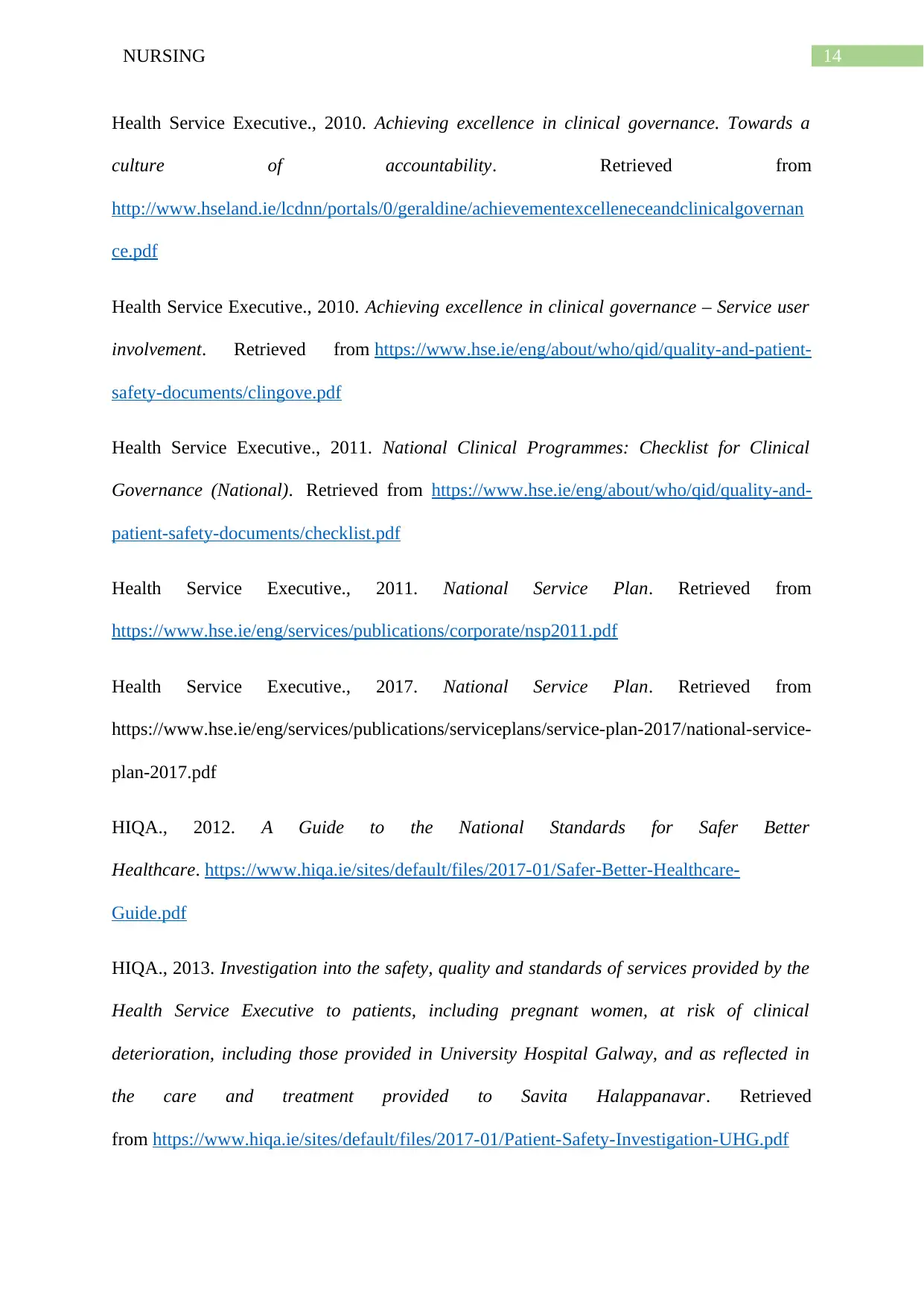
14NURSING
Health Service Executive., 2010. Achieving excellence in clinical governance. Towards a
culture of accountability. Retrieved from
http://www.hseland.ie/lcdnn/portals/0/geraldine/achievementexcelleneceandclinicalgovernan
ce.pdf
Health Service Executive., 2010. Achieving excellence in clinical governance – Service user
involvement. Retrieved from https://www.hse.ie/eng/about/who/qid/quality-and-patient-
safety-documents/clingove.pdf
Health Service Executive., 2011. National Clinical Programmes: Checklist for Clinical
Governance (National). Retrieved from https://www.hse.ie/eng/about/who/qid/quality-and-
patient-safety-documents/checklist.pdf
Health Service Executive., 2011. National Service Plan. Retrieved from
https://www.hse.ie/eng/services/publications/corporate/nsp2011.pdf
Health Service Executive., 2017. National Service Plan. Retrieved from
https://www.hse.ie/eng/services/publications/serviceplans/service-plan-2017/national-service-
plan-2017.pdf
HIQA., 2012. A Guide to the National Standards for Safer Better
Healthcare. https://www.hiqa.ie/sites/default/files/2017-01/Safer-Better-Healthcare-
Guide.pdf
HIQA., 2013. Investigation into the safety, quality and standards of services provided by the
Health Service Executive to patients, including pregnant women, at risk of clinical
deterioration, including those provided in University Hospital Galway, and as reflected in
the care and treatment provided to Savita Halappanavar. Retrieved
from https://www.hiqa.ie/sites/default/files/2017-01/Patient-Safety-Investigation-UHG.pdf
Health Service Executive., 2010. Achieving excellence in clinical governance. Towards a
culture of accountability. Retrieved from
http://www.hseland.ie/lcdnn/portals/0/geraldine/achievementexcelleneceandclinicalgovernan
ce.pdf
Health Service Executive., 2010. Achieving excellence in clinical governance – Service user
involvement. Retrieved from https://www.hse.ie/eng/about/who/qid/quality-and-patient-
safety-documents/clingove.pdf
Health Service Executive., 2011. National Clinical Programmes: Checklist for Clinical
Governance (National). Retrieved from https://www.hse.ie/eng/about/who/qid/quality-and-
patient-safety-documents/checklist.pdf
Health Service Executive., 2011. National Service Plan. Retrieved from
https://www.hse.ie/eng/services/publications/corporate/nsp2011.pdf
Health Service Executive., 2017. National Service Plan. Retrieved from
https://www.hse.ie/eng/services/publications/serviceplans/service-plan-2017/national-service-
plan-2017.pdf
HIQA., 2012. A Guide to the National Standards for Safer Better
Healthcare. https://www.hiqa.ie/sites/default/files/2017-01/Safer-Better-Healthcare-
Guide.pdf
HIQA., 2013. Investigation into the safety, quality and standards of services provided by the
Health Service Executive to patients, including pregnant women, at risk of clinical
deterioration, including those provided in University Hospital Galway, and as reflected in
the care and treatment provided to Savita Halappanavar. Retrieved
from https://www.hiqa.ie/sites/default/files/2017-01/Patient-Safety-Investigation-UHG.pdf
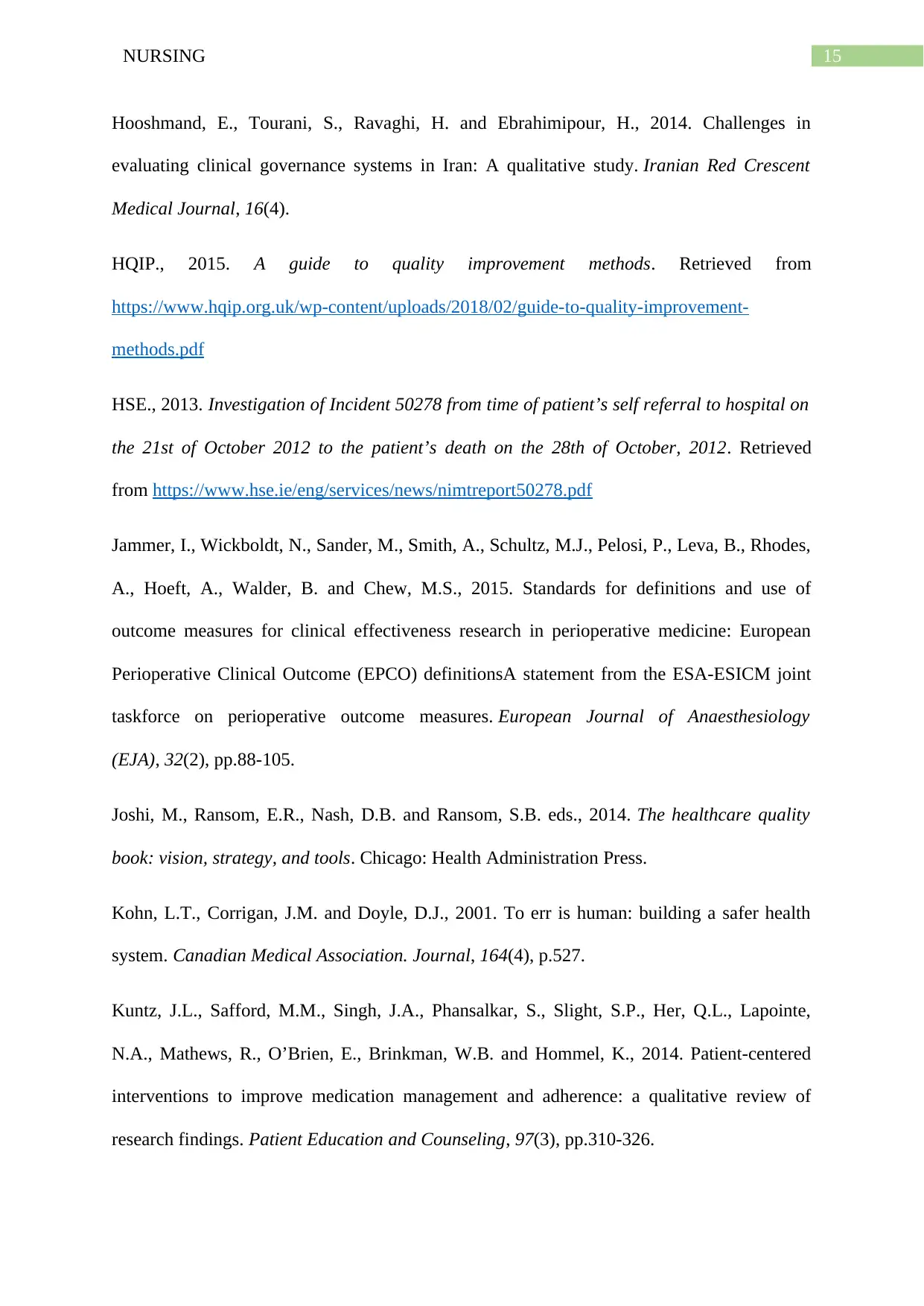
15NURSING
Hooshmand, E., Tourani, S., Ravaghi, H. and Ebrahimipour, H., 2014. Challenges in
evaluating clinical governance systems in Iran: A qualitative study. Iranian Red Crescent
Medical Journal, 16(4).
HQIP., 2015. A guide to quality improvement methods. Retrieved from
https://www.hqip.org.uk/wp-content/uploads/2018/02/guide-to-quality-improvement-
methods.pdf
HSE., 2013. Investigation of Incident 50278 from time of patient’s self referral to hospital on
the 21st of October 2012 to the patient’s death on the 28th of October, 2012. Retrieved
from https://www.hse.ie/eng/services/news/nimtreport50278.pdf
Jammer, I., Wickboldt, N., Sander, M., Smith, A., Schultz, M.J., Pelosi, P., Leva, B., Rhodes,
A., Hoeft, A., Walder, B. and Chew, M.S., 2015. Standards for definitions and use of
outcome measures for clinical effectiveness research in perioperative medicine: European
Perioperative Clinical Outcome (EPCO) definitionsA statement from the ESA-ESICM joint
taskforce on perioperative outcome measures. European Journal of Anaesthesiology
(EJA), 32(2), pp.88-105.
Joshi, M., Ransom, E.R., Nash, D.B. and Ransom, S.B. eds., 2014. The healthcare quality
book: vision, strategy, and tools. Chicago: Health Administration Press.
Kohn, L.T., Corrigan, J.M. and Doyle, D.J., 2001. To err is human: building a safer health
system. Canadian Medical Association. Journal, 164(4), p.527.
Kuntz, J.L., Safford, M.M., Singh, J.A., Phansalkar, S., Slight, S.P., Her, Q.L., Lapointe,
N.A., Mathews, R., O’Brien, E., Brinkman, W.B. and Hommel, K., 2014. Patient-centered
interventions to improve medication management and adherence: a qualitative review of
research findings. Patient Education and Counseling, 97(3), pp.310-326.
Hooshmand, E., Tourani, S., Ravaghi, H. and Ebrahimipour, H., 2014. Challenges in
evaluating clinical governance systems in Iran: A qualitative study. Iranian Red Crescent
Medical Journal, 16(4).
HQIP., 2015. A guide to quality improvement methods. Retrieved from
https://www.hqip.org.uk/wp-content/uploads/2018/02/guide-to-quality-improvement-
methods.pdf
HSE., 2013. Investigation of Incident 50278 from time of patient’s self referral to hospital on
the 21st of October 2012 to the patient’s death on the 28th of October, 2012. Retrieved
from https://www.hse.ie/eng/services/news/nimtreport50278.pdf
Jammer, I., Wickboldt, N., Sander, M., Smith, A., Schultz, M.J., Pelosi, P., Leva, B., Rhodes,
A., Hoeft, A., Walder, B. and Chew, M.S., 2015. Standards for definitions and use of
outcome measures for clinical effectiveness research in perioperative medicine: European
Perioperative Clinical Outcome (EPCO) definitionsA statement from the ESA-ESICM joint
taskforce on perioperative outcome measures. European Journal of Anaesthesiology
(EJA), 32(2), pp.88-105.
Joshi, M., Ransom, E.R., Nash, D.B. and Ransom, S.B. eds., 2014. The healthcare quality
book: vision, strategy, and tools. Chicago: Health Administration Press.
Kohn, L.T., Corrigan, J.M. and Doyle, D.J., 2001. To err is human: building a safer health
system. Canadian Medical Association. Journal, 164(4), p.527.
Kuntz, J.L., Safford, M.M., Singh, J.A., Phansalkar, S., Slight, S.P., Her, Q.L., Lapointe,
N.A., Mathews, R., O’Brien, E., Brinkman, W.B. and Hommel, K., 2014. Patient-centered
interventions to improve medication management and adherence: a qualitative review of
research findings. Patient Education and Counseling, 97(3), pp.310-326.
Secure Best Marks with AI Grader
Need help grading? Try our AI Grader for instant feedback on your assignments.

16NURSING
Lawton, R., Taylor, N., Clay-Williams, R. and Braithwaite, J., 2014. Positive deviance: a
different approach to achieving patient safety. BMJ Qual Saf, pp.bmjqs-2014.
Leguelinel-Blache, G., Arnaud, F., Bouvet, S., Dubois, F., Castelli, C., Roux-Marson, C.,
Ray, V., Sotto, A. and Kinowski, J.M., 2014. Impact of admission medication reconciliation
performed by clinical pharmacists on medication safety. European journal of internal
medicine, 25(9), pp.808-814.
Livingston, G., Kelly, L., Lewis-Holmes, E., Baio, G., Morris, S., Patel, N., Omar, R.Z.,
Katona, C. and Cooper, C., 2014. A systematic review of the clinical effectiveness and cost-
effectiveness of sensory, psychological and behavioural interventions for managing agitation
in older adults with dementia. Health technology assessment (Winchester, England), 18(39),
p.1.
Mitchell, I., Schuster, A., Smith, K., Pronovost, P. and Wu, A., 2016. Patient safety incident
reporting: a qualitative study of thoughts and perceptions of experts 15 years after ‘To Err is
Human’. BMJ Qual Saf, 25(2), pp.92-99.
Nursing and Midwifery Board of Ireland., 2007. Guidance to Nurses and Midwives on
Medication Management. Retrieved from
https://www.nmbi.ie/NMBI/media/NMBI/Guidance-Medicines-Management_1.pdf
Renedo, A., Marston, C.A., Spyridonidis, D. and Barlow, J., 2015. Patient and Public
Involvement in Healthcare Quality Improvement: How organizations can help patients and
professionals to collaborate. Public Management Review, 17(1), pp.17-34.
Royal College of Nursing., 2018. Clinical Governance. Retrieved from
https://www.rcn.org.uk/clinical-topics/clinical-governance
Lawton, R., Taylor, N., Clay-Williams, R. and Braithwaite, J., 2014. Positive deviance: a
different approach to achieving patient safety. BMJ Qual Saf, pp.bmjqs-2014.
Leguelinel-Blache, G., Arnaud, F., Bouvet, S., Dubois, F., Castelli, C., Roux-Marson, C.,
Ray, V., Sotto, A. and Kinowski, J.M., 2014. Impact of admission medication reconciliation
performed by clinical pharmacists on medication safety. European journal of internal
medicine, 25(9), pp.808-814.
Livingston, G., Kelly, L., Lewis-Holmes, E., Baio, G., Morris, S., Patel, N., Omar, R.Z.,
Katona, C. and Cooper, C., 2014. A systematic review of the clinical effectiveness and cost-
effectiveness of sensory, psychological and behavioural interventions for managing agitation
in older adults with dementia. Health technology assessment (Winchester, England), 18(39),
p.1.
Mitchell, I., Schuster, A., Smith, K., Pronovost, P. and Wu, A., 2016. Patient safety incident
reporting: a qualitative study of thoughts and perceptions of experts 15 years after ‘To Err is
Human’. BMJ Qual Saf, 25(2), pp.92-99.
Nursing and Midwifery Board of Ireland., 2007. Guidance to Nurses and Midwives on
Medication Management. Retrieved from
https://www.nmbi.ie/NMBI/media/NMBI/Guidance-Medicines-Management_1.pdf
Renedo, A., Marston, C.A., Spyridonidis, D. and Barlow, J., 2015. Patient and Public
Involvement in Healthcare Quality Improvement: How organizations can help patients and
professionals to collaborate. Public Management Review, 17(1), pp.17-34.
Royal College of Nursing., 2018. Clinical Governance. Retrieved from
https://www.rcn.org.uk/clinical-topics/clinical-governance
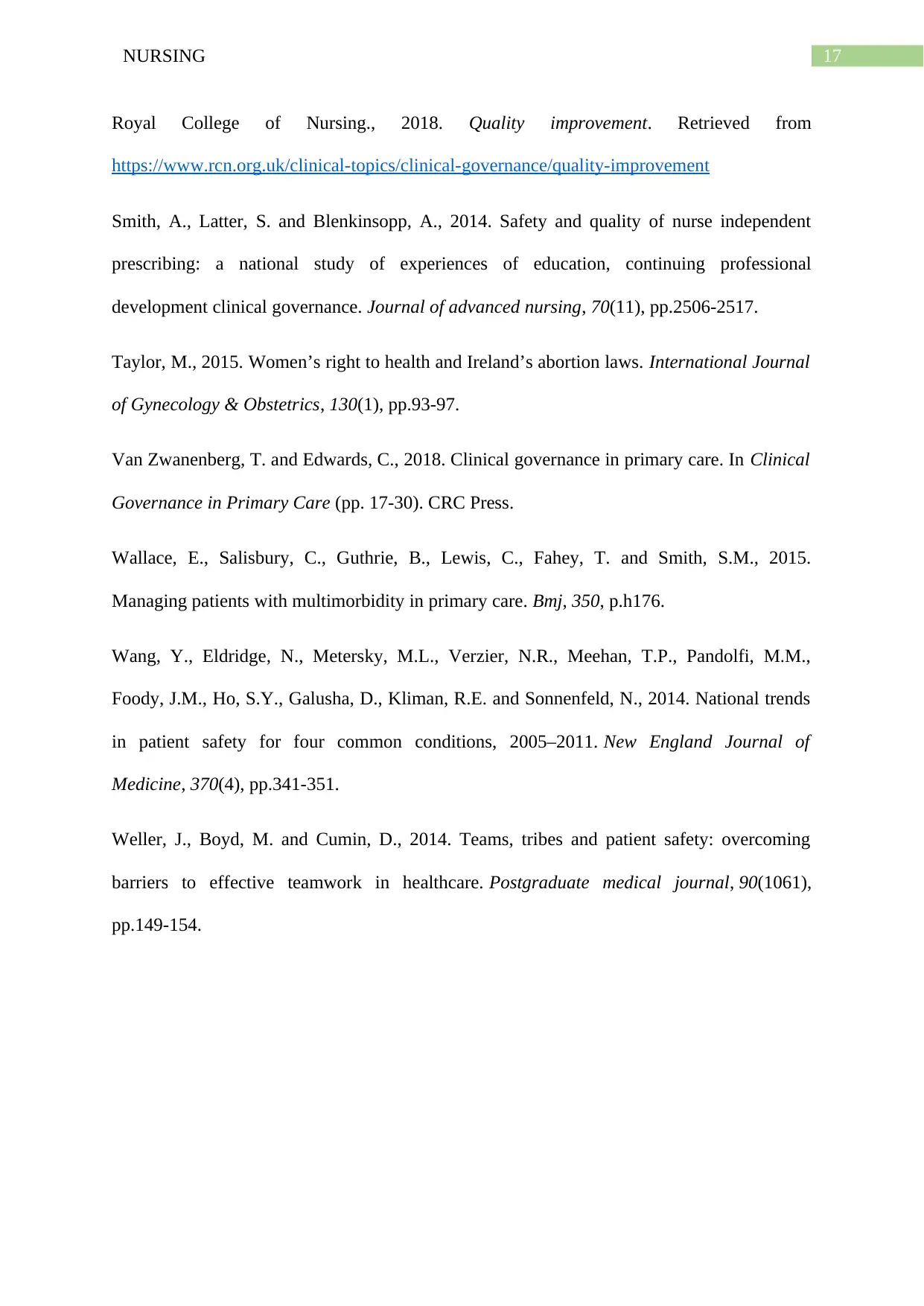
17NURSING
Royal College of Nursing., 2018. Quality improvement. Retrieved from
https://www.rcn.org.uk/clinical-topics/clinical-governance/quality-improvement
Smith, A., Latter, S. and Blenkinsopp, A., 2014. Safety and quality of nurse independent
prescribing: a national study of experiences of education, continuing professional
development clinical governance. Journal of advanced nursing, 70(11), pp.2506-2517.
Taylor, M., 2015. Women’s right to health and Ireland’s abortion laws. International Journal
of Gynecology & Obstetrics, 130(1), pp.93-97.
Van Zwanenberg, T. and Edwards, C., 2018. Clinical governance in primary care. In Clinical
Governance in Primary Care (pp. 17-30). CRC Press.
Wallace, E., Salisbury, C., Guthrie, B., Lewis, C., Fahey, T. and Smith, S.M., 2015.
Managing patients with multimorbidity in primary care. Bmj, 350, p.h176.
Wang, Y., Eldridge, N., Metersky, M.L., Verzier, N.R., Meehan, T.P., Pandolfi, M.M.,
Foody, J.M., Ho, S.Y., Galusha, D., Kliman, R.E. and Sonnenfeld, N., 2014. National trends
in patient safety for four common conditions, 2005–2011. New England Journal of
Medicine, 370(4), pp.341-351.
Weller, J., Boyd, M. and Cumin, D., 2014. Teams, tribes and patient safety: overcoming
barriers to effective teamwork in healthcare. Postgraduate medical journal, 90(1061),
pp.149-154.
Royal College of Nursing., 2018. Quality improvement. Retrieved from
https://www.rcn.org.uk/clinical-topics/clinical-governance/quality-improvement
Smith, A., Latter, S. and Blenkinsopp, A., 2014. Safety and quality of nurse independent
prescribing: a national study of experiences of education, continuing professional
development clinical governance. Journal of advanced nursing, 70(11), pp.2506-2517.
Taylor, M., 2015. Women’s right to health and Ireland’s abortion laws. International Journal
of Gynecology & Obstetrics, 130(1), pp.93-97.
Van Zwanenberg, T. and Edwards, C., 2018. Clinical governance in primary care. In Clinical
Governance in Primary Care (pp. 17-30). CRC Press.
Wallace, E., Salisbury, C., Guthrie, B., Lewis, C., Fahey, T. and Smith, S.M., 2015.
Managing patients with multimorbidity in primary care. Bmj, 350, p.h176.
Wang, Y., Eldridge, N., Metersky, M.L., Verzier, N.R., Meehan, T.P., Pandolfi, M.M.,
Foody, J.M., Ho, S.Y., Galusha, D., Kliman, R.E. and Sonnenfeld, N., 2014. National trends
in patient safety for four common conditions, 2005–2011. New England Journal of
Medicine, 370(4), pp.341-351.
Weller, J., Boyd, M. and Cumin, D., 2014. Teams, tribes and patient safety: overcoming
barriers to effective teamwork in healthcare. Postgraduate medical journal, 90(1061),
pp.149-154.
1 out of 18
Related Documents
Your All-in-One AI-Powered Toolkit for Academic Success.
+13062052269
info@desklib.com
Available 24*7 on WhatsApp / Email
![[object Object]](/_next/static/media/star-bottom.7253800d.svg)
Unlock your academic potential
© 2024 | Zucol Services PVT LTD | All rights reserved.





